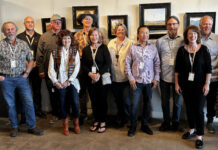
Saskatchewan painter Mike Keepness has a habit of photographing his paintings in the field, and showing his palette and mixing area in the picture. The result is an interesting look at one artist’s evolving use of color.

Keepness painting in Grand Teton National Park in Wyoming
Keepness says he does it as a way to connect with the larger world of plein air painters; he posts many of the photos to Facebook. (You can see more than 100 of them here.) “The area where I live doesn’t have a lot of plein air painters,” he says. “I feel alone out here, to tell you the truth. It feels like the middle of nowhere. To find a group of plein air painters on Facebook is so inspiring. I may be alone when I’m painting out there, but I am able to share my experiences with the whole world. And I like to show my color palette because I have always been interested in various palettes and I have experimented quite a bit.”

“The Stillness of Winter,” by Mike Keepness, oil on gessoed hardboard, 12 x 14 in.
The artist travels down from Saskatchewan, the Canadian province just north of Montana, to take workshops and network with other painters, and he counts a workshop with Clyde Aspevig among the more notable events. Through these trips and through study, Keepness has become a student of palettes. For years, he used the palette of one of his mentors, Saskatchewan painter Dwayne Harty, who uses 17 colors. “I adopted his palette for the longest time,” says Keepness. “But I found it hard to harmonize all those colors. And if you travel, it’s a whole new ballgame again, with new colors needed.”
His reaction was to start cutting down on colors. Viridian hung in there longer than most other hues. But as time passed, he ended up with a split primary palette — and then eliminated one of the blues when he felt Prussian blue could fulfill all his needs. In earlier days, Keepness had four blues on his palette. They dwindled. “I had a hard time saying goodbye to ultramarine blue,” he says. “It’s a wonderful color and it’s on everybody’s palette. But you have to be true to yourself and be experimental. I didn’t like the greens I was getting with ultramarine. That’s why I had viridian on there for a while.”

“Val Port Marsh,” by Mike Keepness, oil on canvas board, 9 x 12 in.
His current palette consists of cadmium red light, alizarin crimson, cadmium yellow medium, lemon yellow, Prussian blue, and a revolving cast of whites — but mostly titanium white. He is not afraid to squirt out some black on occasion. “With this new limited palette, I know I’m a lot faster at capturing a moment because there are not so many choices anymore,” says Keepness. “I can just get right to it and grab the light as fast as I can. My paintings are starting to sing a little bit more, too.”

“Mud Cliffs,” by Mike Keepness, oil on canvas board, 9 x 12 in. “This area is about 20 minutes from my home, and for me it’s a never-ending source of ideas,” says Keepness. “I love to paint mud cliffs, with all the textures and subtle color shifts.”
Isn’t Prussian blue almost as bossy as phthalocyanine blue? “With it, I can get all the subtle blue colors that I need for winter painting,” says Keepness. “I’ve heard many negative things about its intensity from different artists, but I took it as a personal challenge to use it and I’m fairly pleased. Even though Prussian blue is a very strong color, if you control it properly, it has many wonderful rewards, with just that one blue.”

“Winter Light,” by Mike Keepness, 9 x 12 in. This palette dates back to when Keepness was still using viridian.
Next question: Are earth tones trouble with this palette? “I said goodbye to burnt umber and a lot of other really great colors to get to where I am, but the truth is that browns mixed with a bit of Prussian blue make it all harmonize better,” Keepness says. “I’m able to create earth tones and bend color back and forth, warm to cool, with ease using this limited palette. It becomes a feel after a while, and now I mix earth tones without actually thinking about it. I like painting warm cliffs and riverbeds, so I have done it a lot and can get to my earth colors really fast.”

“Craven Valley Winter,” by Mike Keepness, oil on hardboard, 10 x 12 in.
The limited palette evidently suits him. “Simple is best and less is more most of the time for this prairie boy,” says Keepness. “Just because there is strong-colored foliage around me doesn’t mean I have to put that in. I always ask myself, is this the main character of the film? Everything has to support the whole. If everything is important, then nothing, in the end, will be important.”





Hurry Up Zinio !!!